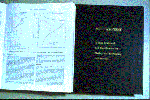 |
Thus far, we have presented an overview of soil classification
within the Aridisol Order. Quantitative definitions of the diagnostic
soil horizons, soil moisture and temperature regimes, and other
classification criteria can be found in Soil Taxonomy and
the 9th
edition web site. Information on Soil Series of a particular
Soil Taxonomic classification can be accessed at the OSD
Web site.
|
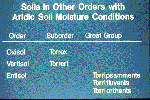 |
Not all soils in arid regions classify in the Aridisol Order. Many
have unique characteristics which place them into other soil Orders.
The aridic soil moisture condition of these soils is denoted by
the formative adjective "torr" or "torri," added
to the Suborder or Great Group name. These adjectives are derived
from the Latin word torridus, meaning hot and dry.
|
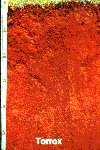 |
For instance, Oxisols are extremely weathered soils of tropical
and subtropical regions. They consist mostly of quartz, low activity
clays, and iron and aluminum oxides. At present, some Oxisols occur
in arid regions due to global climatic changes. These soils comprise
the Torrox Suborder. (Note that in the arid regions covered by this
project, Oxisols are found only in a the small area of Hawaii that
is arid.)
|
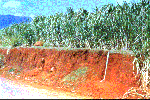 |
Without amendments most Oxisols have low productivity for cultivated
plants because their strongly weathered minerals release few plant
nutrients. However, with fertilization, many Oxisols are highly
productive. The irrigated Torrox soils here are growing sugar cane.
|
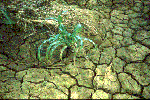 |
Soils with high amounts of swelling type clays that have deep wide
cracks at some time of the year classify in the Vertisol Order.
A significant amount of material from the upper part of the profile
may fall into the cracks, giving rise to a partial inversion of
the soil.
|
 |
Torrerts are the Vertisols with aridic soil moisture conditions.
Unless irrigated they have cracks that stay open throughout most
of the year. The location of Torrerts in low lying areas combined
with their normally good fertility characteristics make them important
agricultural soils in some arid regions of the world.
|
 |
Mineral soils that show little or no evidence of development of
pedogenic horizons classify as Entisols. Three Entisol Great Groups
have aridic soil moisture conditions; Torripsamments, Torrifluvents,
and Torriorthents.
|
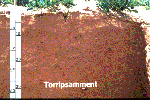 |
Torripsamments are the sandy Entisols. They are usually too droughty
and infertile to be made agriculturally productive without careful
irrigation and fertilizer management. The formative element "psamm"
is derived from the Greek psammos meaning sand.
|
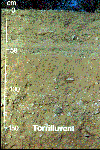 |
Torrifluvents are recently deposited soils of alluvial plains which
are periodically flooded. Stratification of alluvium, as seen here,
is normal. The formative element "fluv" is derived from
the Latin fluvus meaning "river."
|
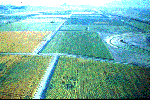 |
Torrifluvents make up a high proportion of irrigated soils in desert
regions because they are normally located close to water, have gentle
slopes and deep, medium textured profiles.
|
 |
Torriorthents are the dry or salty Entisols of arid regions. They
have aridic soil moisture conditions or high soluble salt concentrations
or both. Some Torriorthents lack horizon development because they
occur on steep active slopes or eroded parts of the landscape. Others,
like the Torriorthent illustrated here, are very young soils.
|

